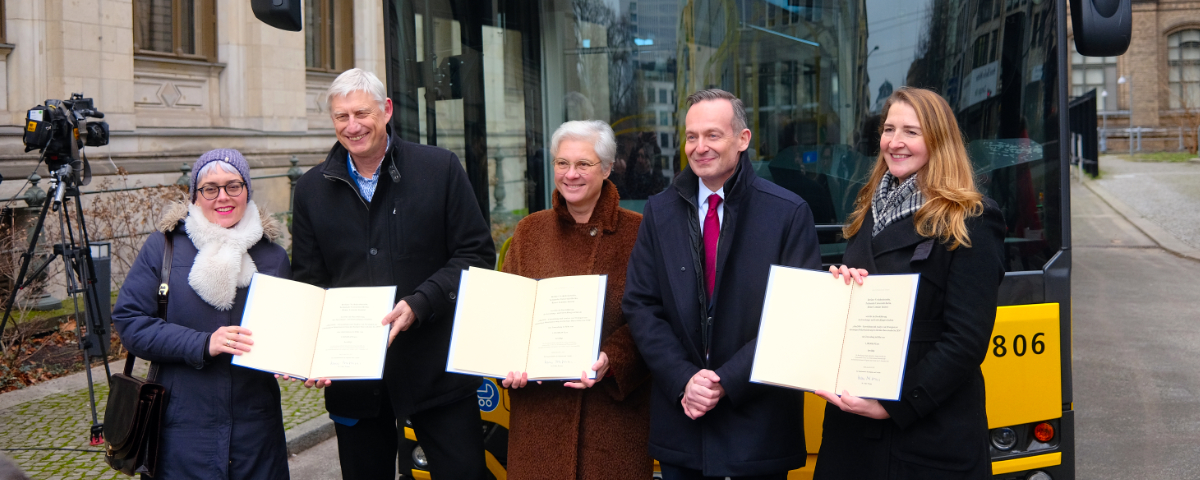Development of a location tool to determine the charging location of electric vehicles (Schiel 2022)
25. January 2023
Kickoff for project about decarbonizing Berlin bus transport
26. January 2023Comparative analysis of spatial requirements of different EU decarbonization scenarios

This analysis aims to identify the space requirements of five different decarbonization scenarios of the European energy infrastructure. The insights gained will facilitate discussions with various stakeholders, such as politicians, citizens and grid operators, and accelerate decarbonization in the energy sector. In addition to the PAC scenario (Paris Agreement Compatible Scenario for Energy Infrastructure), four other decarbonization scenarios will be defined and analyzed together with an expert group, as part of the project. Furthermore, the analysis identifies intermediate requirements of the 2030 climate and energy targets at the EU level.
Results analysis: energy infrastructure, space and water requirements
The analysis for the defined scenarios is performed using a sector-coupled, open optimization tool for the European energy system: the latest version of PyPSA-Eur-Sec. With its help, the required energy infrastructure and its space and water requirements can be determined for each EU country. The basis for the space requirements are the potential areas for photovoltaic as well as onshore and offshore wind power plants, which were determined with the PyPSA-Eur-Sec model.
Additionally, there are the areas that are already being used for plants. The water demand of the operated power plants is estimated by literature data. In addition, insights will be gained through a workshop with stakeholders relevant to the transformation of the energy system. These will be incorporated into the analysis.
Disclosure of results under free license
To visualize the generated data in an easily accessible online format, the project team is developing a user-friendly website. Here, the key results of the analysis, as interactive graphics, will be made publicly available. A corresponding dataset will also be made available under an open license. The report includes methods, assumptions, a comprehensive set of maps, and key conclusions as broad policy recommendations. It will be published in English.
This project also has its own website that can be found here.
Project duration: February 2023 - July 2023
Results analysis: energy infrastructure, space and water requirements
The analysis for the defined scenarios is performed using a sector-coupled, open optimization tool for the European energy system: the latest version of PyPSA-Eur-Sec. With its help, the required energy infrastructure and its space and water requirements can be determined for each EU country. The basis for the space requirements are the potential areas for photovoltaic as well as onshore and offshore wind power plants, which were determined with the PyPSA-Eur-Sec model.
Additionally, there are the areas that are already being used for plants. The water demand of the operated power plants is estimated by literature data. In addition, insights will be gained through a workshop with stakeholders relevant to the transformation of the energy system. These will be incorporated into the analysis.
Disclosure of results under free license
To visualize the generated data in an easily accessible online format, the project team is developing a user-friendly website. Here, the key results of the analysis, as interactive graphics, will be made publicly available. A corresponding dataset will also be made available under an open license. The report includes methods, assumptions, a comprehensive set of maps, and key conclusions as broad policy recommendations. It will be published in English.
This project also has its own website that can be found here.
Project duration: February 2023 - July 2023
In this project, RLI conducts the following taks:
- Definition of five decarbonization scenarios for Europe
- Simulation of the scenarios with the PyPSA-Eur-Sec model
- Identification of space and water requirements for energy infrastructure per EU country or at a higher level of aggregation, as appropriate
- Identification of intermediate requirements of the 2030 climate and energy targets at the EU level
- Developing a user-friendly website and creating interactive graphics
- Writing of a report
- Organization of a workshop with relevant stakeholders
- Project management
The project report can be found here.
Here you can find the homepage with documents summing up the final workshop.
Discover the visualization tool designed as part of this project.
Here you can find the homepage with documents summing up the final workshop.
Discover the visualization tool designed as part of this project.








